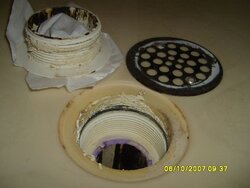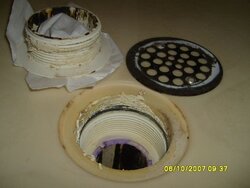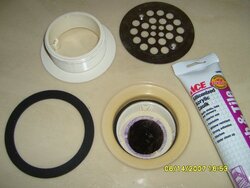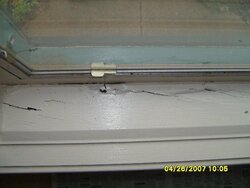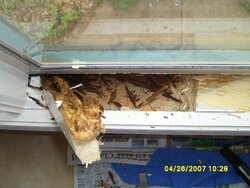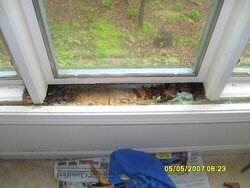Well, stuff continues to fail in my house at a break-neck pace.
A few days ago I noticed water dripping from the ceiling in the downstairs bathroom. Actually coming out of the A/C register. After thinking I fixed it by caulking a bad seam in the shower area, I let the Mrs. take one of those really long showers and "Oh my gosh", water was everywhere. Worse than before.
Current diagnosis: leaky shower floor drain.
I've got it apart. It screws off after getting the grate removed. There seems to be a rubber o-ring that takes care of the main business, and some plumber's putty that looks unnecessary in this drain due to the funnel shape of the fiberglass shower floor.
I'm thinking maybe the screw part just came loose after 20 years, allowing the o-ring seal to loosen and leak, and all I might need to do is tighten it again, but I'm a bit afraid to turn Mrs. Mo loose in there again for a repeat performance.
Questions:
Ever fix one of these yourself? (A "Yes" qualifies you to answer the remaining questions.)
Do you think tightening, or replacing the o-ring, will fix things?
Can you buy replacement o-rings for those drains at the hardware store?
Should I just put some silicone or some other type sealing on the o-ring, or in place of the o-ring, and retighten things?
A few days ago I noticed water dripping from the ceiling in the downstairs bathroom. Actually coming out of the A/C register. After thinking I fixed it by caulking a bad seam in the shower area, I let the Mrs. take one of those really long showers and "Oh my gosh", water was everywhere. Worse than before.
Current diagnosis: leaky shower floor drain.
I've got it apart. It screws off after getting the grate removed. There seems to be a rubber o-ring that takes care of the main business, and some plumber's putty that looks unnecessary in this drain due to the funnel shape of the fiberglass shower floor.
I'm thinking maybe the screw part just came loose after 20 years, allowing the o-ring seal to loosen and leak, and all I might need to do is tighten it again, but I'm a bit afraid to turn Mrs. Mo loose in there again for a repeat performance.
Questions:
Ever fix one of these yourself? (A "Yes" qualifies you to answer the remaining questions.)
Do you think tightening, or replacing the o-ring, will fix things?
Can you buy replacement o-rings for those drains at the hardware store?
Should I just put some silicone or some other type sealing on the o-ring, or in place of the o-ring, and retighten things?


